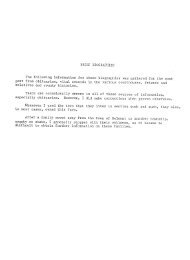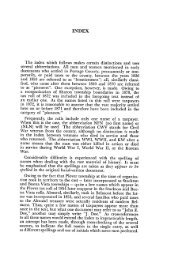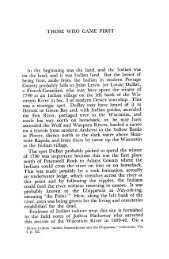Chapter 5: Creeks, Rivers, Lakes & Ponds, Bridges (History ... - Library
Chapter 5: Creeks, Rivers, Lakes & Ponds, Bridges (History ... - Library
Chapter 5: Creeks, Rivers, Lakes & Ponds, Bridges (History ... - Library
You also want an ePaper? Increase the reach of your titles
YUMPU automatically turns print PDFs into web optimized ePapers that Google loves.
CHAPTER 5<br />
CREEKS<br />
RIVERS<br />
LAKES & PONDS<br />
BRIDGES
CREEKS TO RIVERS AND ON THEY FLOW<br />
The Pearl Creek, sometimes referred to as the Dopp Creek, starts in section<br />
26, Township of Belmont, Portage County, running in a southeasterly direction,<br />
crossing section 36 and into Waupaca County, where in the northwest corner of section<br />
31, Township of Dayton, Waupaca, it becomes the Radley Creek. Presumably<br />
named after the Radleys of that area.<br />
In the 1923 plat book of the Town of Dayton, it shows the Pearl Creek joining<br />
the Murry Creek, in section 20, in the Township of Dayton and from there on<br />
it was called the South Fork of the Waupaca River, emptying into Junction Lake, in<br />
section 10, Township of Dayton.<br />
The Radley Creek, as it is known today (1982), flows in a northeasterly<br />
direction from its entry into section 31, Township of Dayton, to where in section<br />
29, in the same Township, it is joined by the Murry Creek coming in from the west.<br />
On they flow together as one, and into Junction Lake.<br />
The Murry Creek, sometimes referred to as the Mclnroe Creek, has its start<br />
in section 22, Township of Belmont, and runs nearly straight east, leaving the<br />
Township of Belmont in section 24, then crossing the extreme southwest corner of<br />
section 19, Township of Dayton, Waupaca County, into section 29, on the extreme<br />
north side where it empties into the Radley.<br />
Here in Junction Lake, named for obvious reasons, in section 10, Township of<br />
Dayton, Waupaca County, the Radley is joined by the Emmons Creek, also originating<br />
in the Township of Belmont. The Emmons and the Radley are both considered top<br />
trout streams.<br />
The largest flow of water leaving the Township of Belmont is the Emmons Creek.<br />
It has its start approximately thirty rods west of Fountain Lake in section 10.<br />
There is here a large culvert under the roadway to allow the excess water from<br />
heavy rains or melting snow to pass through. This empties into a deep ravine<br />
that has been formed by the ravages of time.<br />
In this ravine, water starts seeping in from the underground springs and<br />
then finds its way into Fountain Lake and on its way to the great Atlantic Ocean.<br />
Over the dam on the east end of Fountain Lake, into the old Grant mill creek,<br />
on through the old open dam site of the Grant mill, and the Emmons Creek is on<br />
its way.<br />
Below the original old bridge on the east end of Fountain Lake and below<br />
the falls of the Grant mill, were both excellent holes where the local natives<br />
would spear suckers by the bushel in the springtime.<br />
This was an annual fun time, until the Game Wardens finally brought it<br />
to an end.<br />
Several rods below the Grant mill site, a small spring fed creek, often<br />
referred to as the Rocky Run, empties into the Emmons in section 11. The Emmons<br />
is running in a southeasterly direction just before it turns east and is joined<br />
by a creek coming in from the south, from the spring fed Dean Lake, in section<br />
13.<br />
The Emmons turns northeasterly and leaves the Township of Belmont in section<br />
32
12, and enters into section 7, Township of Dayton, Waupaca County, continuing<br />
northeasterly across section 8, before it enters into Long Lake, one of the Chain<br />
O' <strong>Lakes</strong>, in section 5.<br />
The outlet from the Chain O' <strong>Lakes</strong> is from the southeast corner of Long Lake,<br />
where in the 1923 plat book of the Township of Dayton, this outlet stream is called<br />
Arbor Creek as far as Junction Lake, where it first shows the Crystal River.<br />
It is now called the Crystal River from its' beginning, as it leaves Long<br />
Lake. The Crystal River is now noted for its exciting canoe trips. This beautiful<br />
crystal clear water flows eastward down through the picturesque village of<br />
Rural into Junction Lake.<br />
Here in Junction Lake all the water draining from the Township of Belmont's<br />
Pearl, Murry and the Emmons, combined with each tributary melts together as<br />
one, and on out of Junction Lake as the Crystal River they flow.<br />
On the Crystal goes, through Parfreyville and Little Hope where many years<br />
ago it was harnessed for water power to run mills. The Old Red Mill still stands<br />
today, 1984. After leaving the Little Hope Mill pond it soon enters into section<br />
6, Township of Lind, then turning north, it enters section 31, Township of Waupaca,<br />
where it empties into the Old Cary Mill Pond.<br />
On over the dam on the east end of the Old Cary pond, continuing in an<br />
easterly direction, where in the southwest corner of section 17, Township of<br />
Waupaca, it flows into the Waupaca River.<br />
The Waupaca River twists and turns like a serpent in a southeasterly direction<br />
until it empties into Weyauwega Lake, in section 6, Township of Weyauwega. From<br />
the outlet on the east end of Weyauwega Lake it flows southeasterly into section<br />
11, Township of Weyauwega, where it flows into the mighty Wolf River. Here the<br />
Wolf River is flowing southward down through Fremont, into section 5, Township<br />
of Wolf River, Winnebago County and on into the east end of Lake Poygan, at Boom<br />
Bay, across it goes into Lake Winneconne, and out the southeast corner into Lake<br />
Butte Des Morts, where it is joined by the Fox River, in section 34, Township of<br />
Winneconne, Winnebago County. At this junction it is two miles wide and seven<br />
miles in length.<br />
The Fox River leaves Lake Butte Des Morts and moves southeasterly through the<br />
city of Oshkosh and into Lake Winnebago. The current turns northward and leaves<br />
Lake Winnebago at Neenah, in the Township of Neenah, over the dam there and on<br />
into Menasha, in the Township of Menasha and into Little Lake Butte Des Morts.<br />
On the Fox goes northeasterly through Appleton, Kimberly, Little Chute, Combined<br />
Locks and Kaukauna, in Outagamie County, where its power is utilized. Shortly<br />
after passing through Kaukauna, the Fox enters Brown County, traveling northeasterly<br />
across Brown County, it empties into Green Bay at Green Bay.<br />
As we still follow the waters that originated in the Township of Belmont,<br />
we find that from Green Bay the water flows around the thumb of Wisconsin into<br />
the northern end of Lake Michigan, on up through the Straits of Mackinaw, we go,<br />
into Lake Huron, then coming down the east side of the State of Michigan, to the<br />
St. Clair R River r that divides the United States and Canada, on into Lake St. Clair,<br />
passing through Detroit, Michigan and into Lake Erie. Eastward we go to Buffalo,<br />
New York, down over the mighty Niagara Falls into Lake Ontario, where it leaves<br />
the Great <strong>Lakes</strong> as the St. Lawrence River running northeasterly into Canada, leavthe<br />
State of New York as its southern border at Cornwall, Quebec, Canada.<br />
33
The St. Lawrence still traveling northeasterly into the Gulf of the St.<br />
Lawrence. Here the current turns southeasterly down between Prince Edward Island<br />
and the southern tip of Newfoundland, where all of the aforesaid creeks and rivers<br />
become lost in the mighty Atlantic Ocean.<br />
So the fresh spring waters that bubble from the ground in the Township of<br />
Belmont, Portage County, Wisconsin, can find it's way to the Atlantic Ocean and<br />
even far beyond if it wishes.<br />
LAKES AND PONDS<br />
The Township of Belmont has five lakes all completely within it's borders,<br />
not counting the several frog ponds which never completely disappear even in dry<br />
years, and some that do dry up depending upon the underground water table.<br />
Pine Lake lies totally in section 5 and is approximately 28 acres in area.<br />
Pleasant Lake lies totally in section 6 and is approximately 18 acres in area.<br />
Pickerel Lake lies partly in section 5 and partly in section 6 and is approximately<br />
50 acres in area.<br />
Neither of these three lakes have an inlet or an outlet. The water area of<br />
these lakes are much smaller now, in 1982, than they were 30 years ago, but the<br />
basic lake beds remain the same. Only the amount of water has diminished in size.<br />
Fountain Lake lies totally in section 10 and is approximately 16 acres in<br />
area. It is fed by clear cool springs. As Mr. Malcolm Rosholt put it so beautifully<br />
in his book, OUR COUNTY, OUR STORY, "Because of it's splendid isolation,<br />
Fountain Lake sets like a star sapphire against a mounting of tree covered hills,<br />
it retains a sense of wild beauty probably unmatched in the county."<br />
In the mid i930's Mr. Clifford Caldwell dug many thousand yards of marl from<br />
this lake.<br />
At about this point in time, Jack Hurd erected a dam on the east end of the<br />
lake to raise the water level and by doing so, he flooded the marsh and bogs on<br />
the north side, making it the size that it is today. It empties out over the dam<br />
on the east end of the lake and on into the Emmons.<br />
Dean Lake lies in section 13 and is approximately 4 acres in size. It is a<br />
small spring fed lake, but is deep in places. Mr. Clifford Caldwell dug his first<br />
marl from this lake. It also drains into the Emmons.<br />
The figures used for the lake areas were taken from a publication called<br />
"71 Wisconsin Maps", produced by the Clarkson Company, Kaukauna, WI. No dates<br />
were shown, but it is believed to have been in the mid 1950's.<br />
The Town of Belmont is one of the very few whose lakes are not built up by<br />
cottages and exposed to their pollution.<br />
The United Methodist Church, Inc., known as Asbury Acres, owns most of the land<br />
around Pleasant Lake and owns all the land around Pickerel Lake, except the rightof-way<br />
that is shown in the Deed to the Maccabee Hall.<br />
Fountain Lake and the area east of it now belongs to the Wisconsin Department<br />
of Natural Resources and is public hunting and fishing grounds.<br />
34
Dean Lake still remains private and is closed to trespassing.<br />
Belmont lies east of the divide, which means that the water all flows in an<br />
easterly direction and finds it's way into the Atlantic Ocean, while on the west<br />
side, toward Almond, all waters flow westerly and find their way into the Gulf of<br />
Mexico.<br />
BRIDGES<br />
In the early days before there was a Township of Belmont and the Indians<br />
roamed their land, there were no bridges as we know them today. The Indians would<br />
ford the creeks and rivers at their most shallow places, so their trails would<br />
often follow a creek or river some distance before they would find a suitable<br />
place to cross.<br />
After the white man came and laid out their roadways, it was necessary to<br />
generally stay in a straight line on a section or quarter section line. Therefore,<br />
a roadway may have to cross a creek, not necessarily at the most shallow place.<br />
None of the three creeks that left the Township of Belmont were ever hub<br />
deep to a high wagon, so it made crossing through these a rather easy matter in<br />
the summer time or warm weather. Winter time and cold weather was a different<br />
matter, so bridges were built over these creeks.<br />
The first bridges were logs laid across the creek, with logs or planks laid<br />
across these. Later came the cement culverts and bridges with iron railings.<br />
One author has written that the first bridge that was built in the Town of Belmont<br />
was built in section 13, between the two Robinson places. This is Stratton Lake<br />
Road today.<br />
There were other bridges and culverts built, such as the one in section 14,<br />
for the Rocky Run Creek, the one over the Mclnroe Creek in section 22 and the Dopp<br />
or Pearl in section 36. There is also another bridge for the Emmons Creek in section<br />
14, the other being the one in section 13 on Stratton Lake Road.<br />
There is a culvert to allow drainage for the excess water from the northeast<br />
quarter of section 10 to pass through. This is under Fountain Lake Ave., at the<br />
base of the hill only a few rods west of Fountain Lake. There was a large concrete<br />
culvert, sometimes called a cow slip, built under the roadway now called Fountain<br />
Lake Avenue in section 11.<br />
James Grant owned five acres of land on the south side of the roadway, so a<br />
cow slip was built to permit his cattle to pass through to get to water. Due to<br />
the vast amounts of soil being washed down from the valley to the north, this culvert<br />
would gradually fill up with sand and would have to be cleaned out. As the<br />
years passed, it took its toll and the culvert finally filled up and was covered<br />
over completely. This old cow slip still lies buried beneath the roadway.<br />
This following bit of information was obtained from some town clerk's old<br />
records.<br />
The Town Board met for the purpose of levying the road and bridge tax. John<br />
Peterson was to be paid $197.00 for work that was to be done on building a culvert<br />
below James Grants' and Charles Sanders'. This was dated September 2, 1899. This<br />
culvert was the same cow slip just mentioned.<br />
35
The most difficult bridge to maintain in the Town of Belmont was the bridge<br />
first built below James Grant in the northwest corner of section 11 and the southwest<br />
corner of section 2. This old bridge was built on what is now County Trunk<br />
"D".<br />
It seems that a bridge of some sort had to be built through this deep ravine,<br />
that had such steep banks on both sides, to prevent further damage to the existing<br />
roadway caused by the water from the spring thaws and heavy rain storms that ran<br />
swiftly through this ravine. These first bridges could be washed out and had to<br />
be filled in again. It seems as if a better bridge was to be built, because in some<br />
old town records, I found this account dated June, 1886.<br />
James Grant was to receive $25.00 to install a bridge with 13 posts on each<br />
side of the roadway, 8 feet apart. The posts were not to be less than 8 to 10<br />
inches in diameter of sound oak and to have substantial railings on the posts.<br />
In the fall of 1920, the present large concrete bridge was built, which makes<br />
this the largest bridge in the Town of Belmont. Several men of the neighborhood<br />
worked on the construction of this bridge either with a team of horses or by hand.<br />
Frank Dent was the road boss at the time.<br />
Dale Sawyer related to me that he worked on the construction of that bridge<br />
with a team of horses that fall, when he could have been hauling his potatoes<br />
right from the field for $1.00 per bushel, but he put them in the cellar until<br />
spring and then sold them for 25 cents per bushel.<br />
THE TOWN OF BELMONT'S LARGEST BRIDGE<br />
36<br />
Grant bridge, built under<br />
County Trunk D, just below<br />
the old Harry Grant farm.<br />
This new bridge allowed<br />
the excess water from spring<br />
thaws or heavy rains to pass<br />
through. The water, from several<br />
hundred acres to the north had<br />
to pass through this draw.
The Grant bridge under construction in the fall of 1920. Frank Dent was<br />
the road foreman. Water drained in bad years through this bridge from sections<br />
two and three and as fat north as Lanark.<br />
The small bridges that were built previous to this would wash out in fast<br />
waters.<br />
37
<strong>History</strong> and Memories: Portage County, Belmont Township Volume 2 - Link Page<br />
Previous <strong>Chapter</strong> 4:Halls: Maccabee, Ward, Brandt, L. D. Scott 24a<br />
Next <strong>Chapter</strong> 6: Club Organizations, Baseball Teams, Horse Shoe Pitching Teams, Bands and Orchestras 37b<br />
Return to Electronic Index Page
















